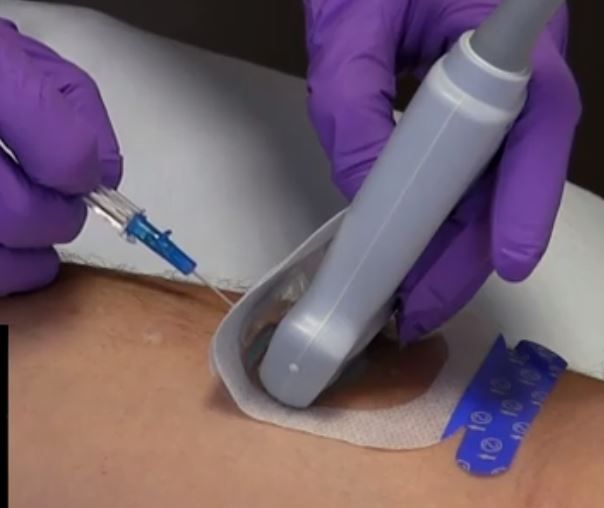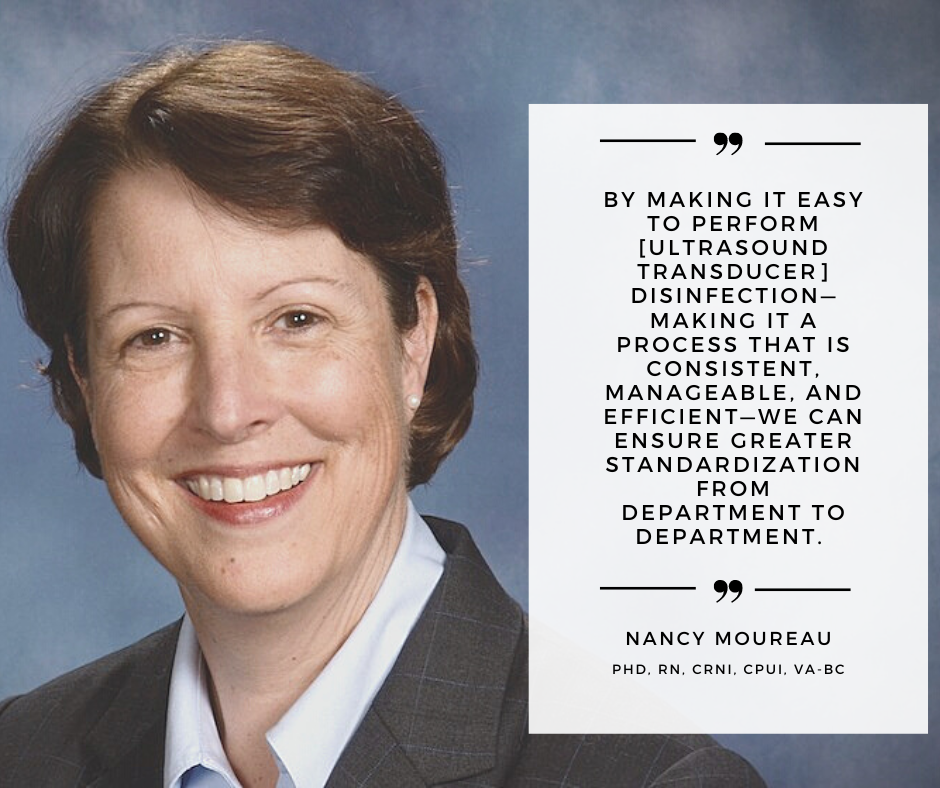Ultrasound Transducers: Avoiding Gel Contamination and Using Proper Level Disinfection
Having complete IV start kits or central line insertion kits to reduce gel type variability and, thus gel contamination and following AIUM and INS disinfection recommendations are 2 ways to prevent health care-acquired infections.
Ultrasound transducer with barrier dressing (Image courtesy PICC Excellence, Hartwell, GA)

Stopping contamination during the use of an ultrasound transducer is vital to preventing health care-acquired infections. Nancy Moureau, RN, PhD, CRNI, CPUI, VA-BC, is an expert in the field of vascular access practice, owner and CEO of PICC Excellence, and a member of Infection Control Today®’s (ICT®)’s editorial board, and she discusses her suggestions to avoid contamination with ICT®. She also examines the controversy of using high-, medium-, or low-level disinfection for ultrasound transducers, what the American Institute for Ultrasound in Medicine (AIUM) and the Infusion Nurses Society (INS) recommend, and how the suggestions differ for vascular access and percutaneous procedures.
This is the third of 4 segments of ICT®’s interview with Moureau. The first segment is here. The second segment is here.
Nancy Moureau, PhD, RN, CRNI, CPUI, VA-B

Infection Today® (ICT®): You mentioned that ultrasound coupling gel has been identified as a source of patient infections. What precautions can practitioners take to prevent the transmission of contamination via that gel?
Nancy Moureau, RN, PhD, CRNI, CPUI, VA-BC: Inmy opinion, the best practice for preventing the transmission of contaminants via gel is not to use gel at the insertion site. We need to have coupling gel that aids in visualization, because ultrasound cannot transmit sound waves through air. It requires some sort of fluid medium or gel in order to be able to visualize the body’s structures.
But the variability and inconsistency that we talked about earlier is widely present in the use of gel. I have walked through a single institution and seen 5 different types of gels used, all of which were nonsterile. That raises the possibility that practitioners are using a nonsterile gel on a sterile insertion site, and effectively pushing that gel into the bloodstream. While I have not found a lot of evidence or research on the impact of gel within the bloodstream, it can’t be a good thing. Gel embolizing in the bloodstream is very likely to create problems that we may or may not be aware of.
If we can eliminate gel from the insertion site by keeping the gel and transducer on the other side of a barrier that still permits visualization of vascular structures, then we may have a home run. That way, variability in gel usage wouldn’t matter. We could use any kind of gel behind the barrier without creating a risk of contamination.
The best way to reduce variability is to have a complete IV start kit or central line insertion kit that clinicians can grab and use at a moment’s notice. Kits should be optimized, efficient, and not very costly, providing everything that’s needed—and nothing that’s not needed. In the case of central line insertions, for instance, sterile gel packets are included in the kits. A well thought-through kit is more likely to have departments and department heads agree to stock it in their areas, and to encourage their clinicians to use it, thus promoting greater standardization.
But just like everything else, there’s a huge amount of variability in the use of kits. Even IV start kits are not consistently used throughout the hospital, where peripheral IVs are inserted just about every minute of every day.
We need to be consistent with our practices, and management needs to enforce the use of these safety supplies—including the use of sterile gel, if gel is used on the skin during insertion. We need to have people enforce best practices—or at least to monitor and encourage those practices—and establish some form of standardization within all hospital departments.
ICT®: What are the key elements of guidelines from the American Institute for Ultrasound in Medicine (AIUM) and the Infusion Nurses Society (INS) regarding the use of ultrasound-guided vascular access procedures?
NM: Both of these organizations have excellent recommendations on the use of visualization technologies. However, the Infusion Nurses Society does not have specific recommendations for processing transducers, other than to say that disinfection should be performed before and after use, which is a very consistent requirement.
Most recently, an American Institute of Ultrasound in Medicine (AIUM) taskforce has published a position statement to clarify the methods used to disinfect transducers in a way that is practical, efficient, and provides a level of safety for patients. The new Intersocietal Position Statement has been accepted by the Infusion Nurses Society (INS) and more than 20 other organizations. It supports the evidence-based position that cleaning and low-level disinfection (LLD) effective against bloodborne pathogens are adequate and sufficient methods for processing transducers used in percutaneous procedures. By contrast, procedures that are invasive or involve contact with mucus membranes would require high-level disinfection.
By making it easy to perform disinfection—making it a process that is consistent, manageable, and efficient—we can ensure greater standardization from department to department. In turn, departments will be able to utilize these visualization technologies in ways that are helpful to patients while optimizing the availability of critical equipment.
Ultrasound guidance improves the success of intravenous or arterial device insertions by making it possible to perform better assessments of veins, and by visually guiding the needle into the vessel. There are a number of advantages associated with the use of ultrasound, so we certainly don’t want to inhibit its use.
ICT®: How should the different levels of cleaning and disinfection be applied to transducers used in percutaneous procedures?
NM: Current practices for the cleaning and disinfection of medical devices are based on the Spaulding Classification System, which was first published in 1957. The Spaulding system calls for different levels of disinfection or sterilization to be used in accord with the clinical application of the device. But the rules of the Spaulding system need to be interpreted differently when dealing with modern devices and procedures, and that’s where the Intersocietal Position Statement comes in. Focusing exclusively on ultrasound-guided percutaneous procedures, the position statement makes the case that ultrasound transducers used in such procedures do not need to undergo the high-level disinfection that might be required for more-invasive procedures.
Moreover, it’s not necessary to use high-level disinfection for transducers that are used with a cover or separating barrier that prevents the bare transducer from ever coming into contact with the insertion site. According to the evidence reviewed by the position statement taskforce—and now endorsed by 22 health professional organizations—it is safe and sufficient to use low-level disinfecting agents or wipes for the disinfection of transducers used in percutaneous procedures, when permitted under the manufacturer’s instructions for use.
Ultrasound transducers or probes that come into contact with mucous membranes or are used in endocavitary procedures (anal, oral, or vaginal) must be processed using high-level disinfection. This level of processing is more costly and time consuming and should not be applied to all types of ultrasound use.
Novel disinfecting agents are becoming available for conveniently performing not only low-level disinfection but also intermediate-level disinfection. In the future, we will have wipes that easily perform the function of high-level disinfection for these types of ultrasound devices.
Robust infectious disease surveillance, including rapid subtyping of influenza A, is essential for early detection, containment, and public health reporting of novel viral threats.